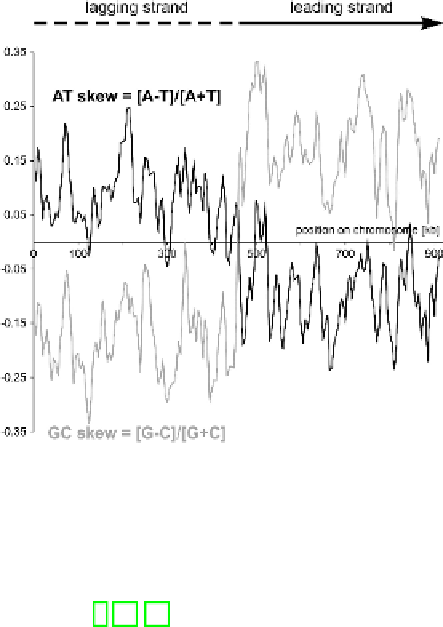Biomedical Engineering Reference
In-Depth Information
Fig. 1.
AT skew and GC skew along the
Borrelia burgdorferi
chromosome calculated in sliding
windows with the length of 10 kb and the shift of 5 kb. Organization of the chromosome into two
differently replicated DNA strands (lagging and leading) is shown above the plot.
The strongest DNA asymmetry associated with replication is observed in the third
codon position of protein coding genes, which indicates that the mutational pressure is
the main reason of this bias [9, 11-13]. The leading strand is usually rich in guanine and
thymine whereas the lagging strand shows excess of cytosine and adenine. It is assumed
that the mutation C to T, which is the most common substitution type observed in the
leading strand, is the main factor responsible for this DNA asymmetry [1] although
analysis of several bacterial genomes revealed that similar compositional biases may
result from different mutational patterns [5]. The effect of the mutational pressure is to
some extent accepted by selection because the DNA asymmetry is also visible in codon
usage of genes and amino acid composition of the coded proteins [14-17].
Interestingly, it was also found that the mutational pressure influences the evolu-
tion rate of genes in dependence of their location on the DNA strands. Genes coded
in the leading strand generally accumulate less substitutions than the lagging strand
genes whereas homologs located on the differently replicated strands in the compared
genomes show the highest divergence [4, 18-20]. Computer simulation of gene evo-
lution using different mutational pressures associated with replication confirmed these
findings and revealed additionally that the best survival strategy for the majority of
genes is switching their location between DNA strands to change the direction of the
pressure from time to time [21-24]. It may explain the observed asymmetric transloca-
tions and non-conserved positions of many genes between differently replicated DNA
strands in compared genomes during evolution [25, 26]. Exceptions from this tendency
are genes coding for ribosomal proteins which do not profit very much from switch-
ing the directional pressure [21]. It is in agreement with their extremely conserved







Search WWH ::

Custom Search